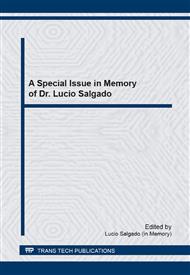[1]
A. Freitas, Estrutura de mercado do segmento de fitoterápicos no contexto atual da indústria farmacêutica brasileira, Ministério da Saúde, (2007).
Google Scholar
[2]
C. Alemdaroğlu, Z. Değim, N. Çelebi, F Zor, S. Öztürk and D. Erdoğan, An investigation on burn wound healing in rats with chitosan gel formulation containing epidermal growth factor, Burns 32 (2006) 319-327.
DOI: 10.1016/j.burns.2005.10.015
Google Scholar
[3]
Muzzarelli, R.A.A., Amphoteric derivatives of chitosan and their biological significance, in Chitin and Chitosan, Elsevier Applied Science, London, (1989).
Google Scholar
[4]
L.L. Balassa, J.F. Prudden, Applications of chitin and chitosan in wound healing acceleration, in Chitin, Chitosan and Related Enzymes, Academic Press, San Diego, (1984).
Google Scholar
[5]
W. Paul, W., C. Sharma, Chitosan and alginate wound dressing: A short review, Trends Biom. Art. Org. 18 (1984) 18-23.
Google Scholar
[6]
S. Wittaya-Areekul, C. Prahsarn, Development and in vitro evaluation of chitosan–polysaccharides composite wound dressings, Int. J. of Pharm. 313 (2006) 123–128.
DOI: 10.1208/pt070130
Google Scholar
[7]
ASTM D882-95 (1995) Standard test method for tensile properties of thin plastic sheeting.
Google Scholar
[8]
BRITISH STANDARDS BS EN 13726-1 (2002) Test methods for primary wound dressings. Part 1: Aspects of Absorbency, section 3. 3 Fluid Handling Capacity.
Google Scholar
[9]
S. Thomas, S. Young, Exudate-handling mechanisms of two foam-film dressings, Journal of Wound Care, 17(7) (2008) 309-315.
DOI: 10.12968/jowc.2008.17.7.30524
Google Scholar
[10]
ASTM E 96-95 (1995) Standard test method for water vapor transmission of materials, Annual Books of ASTM Standards.
Google Scholar
[11]
M. Pereda, M., M.I. Aranguren, N.E. Marcovich, Caseinate films modified with tung oil, Food Hydrocolloids 24 (2010) 800-808.
DOI: 10.1016/j.foodhyd.2010.04.007
Google Scholar
[12]
L. Sánchez-González, M. Vargas, C. González-Martínez, A. Chiralt, M. Cháfer, Characterization of edible films based on hydroxypropylmethylcellulose and tea tree essential oil, Food Hydrocolloids 23 (2009) 2102–2109.
DOI: 10.1016/j.foodhyd.2009.05.006
Google Scholar
[13]
L.O. Lamke, G.E. Nilsson, H.L. Reithner, The evaporative water loss from burns and water vapour permeability of grafts and artificial membranes used in the treatment of burns, Burns 3 (1977) 159-165.
DOI: 10.1016/0305-4179(77)90004-3
Google Scholar
[14]
P.H. Chen, T.Y. Kuo, J.Y. Kuo, Y.P. Tseng, D.M. Wang, J.Y. Lai, H.J. Hsieh, Novel chitosan–pectin composite membranes with enhanced strength, hydrophilicity and controllable disintegration, Carbohydr. Polym. 82 (2010) 1236–1242.
DOI: 10.1016/j.carbpol.2010.06.057
Google Scholar
[15]
M. Pereda, M.I. Aranguren, N.E. Marcovich, Effect of Crosslinking on the Properties of Sodium Caseinate Films, J. Appl. Polym. Sci. 16 (2010) 18–26.
DOI: 10.1002/app.31425
Google Scholar
[16]
P. Wu, A.C. Fisher, P.P. Foo, D. Queen, J.D.S. Gaylor, In vitro assessment of water vapour transmission of synthetic wound dressings, Biomaterials 16(3) (1995) 171-175.
DOI: 10.1016/0142-9612(95)92114-l
Google Scholar
[17]
V. Bifani, C. Ramírez, M. Ihl, M. Rubilar, A. García, N. Zaritzky, Effects of murta (Ugni molinae Turcz) extract on gas and water vapor permeability of carboxymethylcellulose-based edible films, LWT - Food Sci. Technol. 40 (2007) 1473–1481.
DOI: 10.1016/j.lwt.2006.03.011
Google Scholar
[18]
F.M. Pelissari, .M.V.E. Grossmann, F. Yamashita, E.A.G. Pineda, Antimicrobial, Mechanical, and Barrier Properties of Cassava Starch-Chitosan Films Incorporated with Oregano Essential Oil, J. Agric. Food Chem. 57 (2009) 7499–7504.
DOI: 10.1021/jf9002363
Google Scholar
[19]
C.M.P. Yoshida, C.E.N. Bastos, T.T. Franco, Modeling of potassium sorbate diffusion through chitosan films, LWT - Food Sci. Technol. 43 (2010) 584–589.
DOI: 10.1016/j.lwt.2009.10.005
Google Scholar
[20]
L.C. Bertan, P.S. Tanada-Palmu, A.C. Siani, C.R.F. Grosso, Effect of fatty acids and Brazilian elemi, on composite films based on gelatin, Food Hydrocolloids 19 (2005) 73–82.
DOI: 10.1016/j.foodhyd.2004.04.017
Google Scholar
[21]
M. Ghasemlou, F. Khodaiyan, A. Oromiehie, M.S. Yarmand, Characterization of edible emulsified films with low affinity to water based on kefiran and oleic acid, Int. J. Biol. Macromol. 49 (2011) 378– 384.
DOI: 10.1016/j.ijbiomac.2011.05.013
Google Scholar
[22]
M. Pereda, G. Amica, N.E. Marcovich, Development and characterization of edible chitosan/olive oil emulsion films, Carbohydr. Polym. 87 (2012) 1318– 1325.
DOI: 10.1016/j.carbpol.2011.09.019
Google Scholar
[23]
Robertson, G.L. Optical and mechanical properties of thermoplastic polymers, In Robertson, G.L. Food Packaging: principles and practice, Marcell Dekker Inc., New York (1993).
Google Scholar


